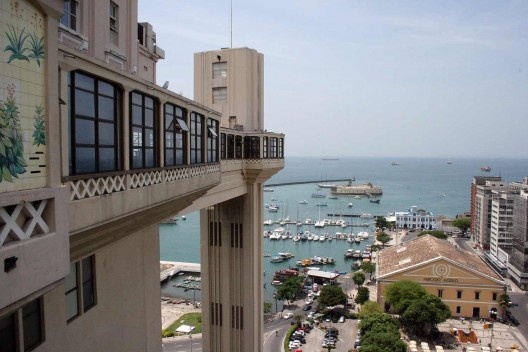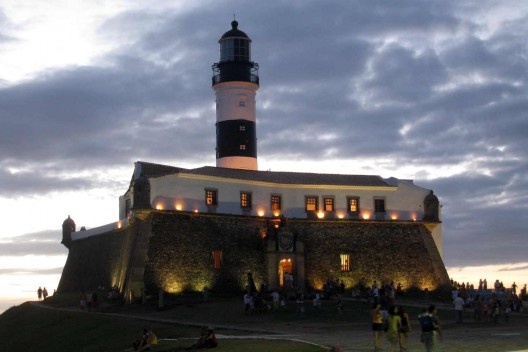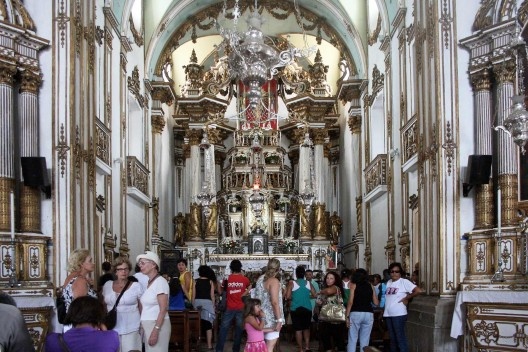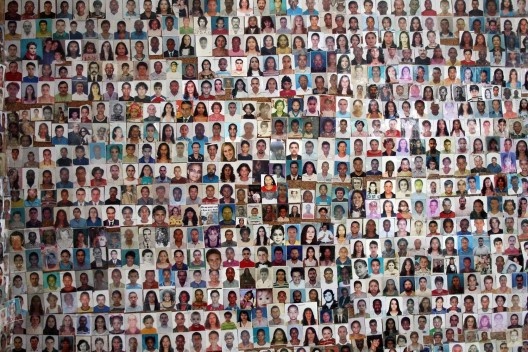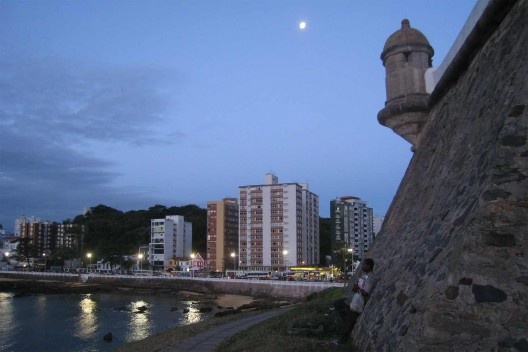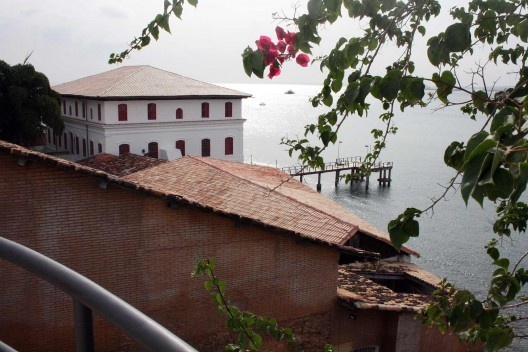Heritage and tourism
Urban heritage has a great visual attractiveness. Inherited urban forms are envisaged as part of the city image and represent an important asset in an increasingly competitive market. Tourist cities face the challenge of high investments not only in the business framework but also in human capital in order to safeguard identity and cultural traditions while stimulating creativity and innovation. The tourist trade operates on the city image through advertising campaigns that promote particular aspects of the landscape, culture and urban features. It also contributes to create labels able to clearly identify places.
Brazil has been marketed almost exclusively as a ‘tropical’ destination and sun-sand based tourism a dominant sector in the national tourist industry, domestic and international. However, as culture has assumed a greater role in urban development, notably from 1980’s onwards, historic centres have begun to experience a process of urban renaissance. This is largely due to tourism activities that have awoken the public interest for buildings, districts and even entire cities that were long before derelict and forgotten (1).
The combination of architecture and history has became a key factor for the local economy in small and medium sized cities while in the big cities “cultural tourism”, as labelled by the market, triggered initiatives to recover historic centres, ruined monuments and buildings.
The case of Salvador
The image of Salvador has been framed around a marketing strategy that understands urban heritage and culture as drivers to foster cultural tourism for different audiences. Salvador has a unique blend of European and African cultures printed in its urban fabric and on local people, a distinguished culture that can be observed in its baroque churches and buildings, in the African sanctuaries, in the religious syncretism, in the gastronomy, music and festivities.
Being the first capital settled in the country Salvador had its image blurred with the Brazilian identity itself. In 2000, for example, to celebrate the five hundred years of Brazil’s discovery the government of Bahia state created the campaign Bahia, o Brasil nasceu aqui (Bahia, where Brazil was born) broadcasting in the national media views of the city, its historic centre, its beaches, its people and its culture.
The old town, known as Pelourinho, has staged one the most ambitious urban renovation programmes in the country in early 1990’s and by 2000 was already a fairly successful tourist attraction. Most of its built heritage was recovered; many buildings were saved from ruining and now they house museums, hotels, restaurants and shops. The ‘new’ Pelourinho was exhaustively advertised as the place to experience the cultura baiana provided by the lively ambience of its quarters (2).
However the particular experience of the Pelourinho renovation programme also caused controversy and raised criticism related to the stimulation of gentrification, transforming a historic place in a spectacle for the mass-consumption that could threaten the local cultural identity and consequently the sustainability of the area.
The process of urban renewal is still ongoing in Pelourinho, although new urban policies and funding schemes brought some changes on the scope of the programme over the years. Nevertheless the “happy city” image – best exemplified in another slogan that refers to Salvador as ‘City of Joy’- is often regarded as an essential part of the tourism strategy.
The local government and private entrepreneurs have been explored aspects such as ‘multi-racial society’, ‘exotic land’, ‘friendly people’, ‘cultural diversity’ and ‘authenticity’ as a tool to achieve the successful implementation of projects designed to improve the urban landscape appeal, despite the visible economic and social inequalities that characterises Salvador.
The decay and recovery of a cultural heritage: Salvador and its historical centre
Salvador was the first colonial capital in Brazil, founded in 1549. In the following two centuries the city was denominated “second city” of Portuguese Empire (after Lisbon) and it was the main port in the South Atlantic.
Although the capital was later moved to Rio de Janeiro, in 1763, the city of Salvador kept a significant role in the economy of the country due to its strategic position and infrastructure, built on export of primary and manufactured goods, mainly concentrated around the sugar cane industry. Such wealth was responsible for the construction of an exuberant colonial city, mostly based on the Portuguese baroque architecture style.
Until the end of the 19th century the city experienced a dynamic urban development, but the consequences of the rapid industrialisation in the Southeast Region (chiefly in the cities of Sao Paulo and Rio de Janeiro), the decline of sugar cane market and the end of slavery, which had provided the ‘free’ labour force for more than three hundred years, brought about economic depression and stagnation.
The scenery changed when oil was discovered on Baia de Todos os Santos (3) in 1950’s, initiating an industrial development that reflected later on in urban modernisation and demographic explosion at the same time, placing Salvador among the biggest metropolises in Brazil (4). During the 20th century the social-economic organisation in the urban space was rearranged. The most drastic effects could be observed in the historical centre of Salvador, which had been steadily abandoned by the middle and upper classes in the first decades.
These effects were intensified during the 1970’s, when traditionally central urban activities were relocated to new quarters in the Northeast part of the city, such as the main coach station, the Convention’s Centre and ultimately the headquarters of the administration offices of Bahia’s government, which were transferred to a modern huge complex in the outskirts of the city, alongside the Paralela motorway and nearby the international airport.
Altogether these events attracted investments that formed a business district characterized by modern buildings and urban infrastructure. By the beginning of 1980 this new “centrality” was consolidated, giving its back to the old town. The degradation in Pelourinho is also regarded as a consequence of a range of factors that have been present in most of the capital cities in Brazil: the growing process of urban sprawl, the lack of public investments in housing programmes and urban infrastructure, and poverty combined with social-spatial exclusion.
City centres became problematic areas for Brazilian local governments, and for the middle class a dangerous, unsafe and dirty neighbourhood to be avoided. This very negative image was even stronger in Salvador. Most of the colonial buildings were fairly run-down by the end of 1960’s when the poor homeless began to invade as squatters. Prostitution and drug trafficking also took place in the dark alleys, elevating the crime rates and fear.
Despite the physical decay a powerful cultural movement emerged in Salvador, based on the very traditions of the Carnival expressed in African-Brazilian music and dance that had been fermenting since the 1950’s. This cultural renaissance was mainly centred on musical groups known as blocos Afro. The first of these groups – Filhos de Gandhi - was founded in 1949; to be followed by Ile Ayie (1974), Olodum (1979), Muzemza (1981), Araketu (1989), Timbalada (1996), among others.
These groups made an enormous success in the national musical scene and even abroad as Olodum stood out internationally through concerts in North America, Europe and Japan, exporting the black culture of Pelourinho and Bahia. The musical movement impacted positively on the image of the city but the big turning point came just after the urban renewal projects undertaken by the State of Bahia government in the 1990’s.
The threatened architectural heritage had been a preoccupation for the local and central governments for quite a long time. The richness of the buildings wasted by lack of maintenance contrasted with the attempts to recover the ancient glamour of the colonial settlement. Indeed between the end of the 1960’s and the beginning of the 1990’s – in a period of less than 30 years - around 25 projects and plans were elaborated in order to renovate the area; none of them was successful (5).
Most of these projects were quite ambitious and foresaw a wide list of urban and social programmes to reverse the degradation process. In 1985 UNESCO awarded the historical centre of Salvador the title of Cultural World Heritage, becoming the second city in Brazil to join the list (6). The nomination increased the pressure on the local authorities increased in terms of taking more effective measures to protect the historical heritage.
Salvador was at that time gaining a solid reputation as a tourist destination in the national market and its Carnival was attracting more and more people every year. The state and local governments had plans to turn the city into a major attraction for the international market as well and the historic centre was certainly a prime asset to be better explored.
Therefore a new programme was launched in 1991 by the State government of Bahia to recover partially the historical centre; in 1994 the inauguration of the “new Pelourinho” took place with many festivities, revealing a revamped landscape, with clean streets, colourful facades and, most of all, a safe environment.
The ‘land of happiness’: branding the city image
In a text for the 2006 edition of the tourist guide ‘Guia Unibanco Brasil: Nordeste’ the Angolan writer Jose Eduardo Agualusa states:
“The Brazilian Northeast region, and especially Salvador da Bahia, became in the last decades a sort of happy Africa, an Africa that worked out, despite of the terrible crime on its origin – the slavery” (7).
This perception of Salvador as the heart of African-Brazilian culture is well established as the city and the surrounding region concentrate until nowadays the large African descendent population. The idea of the ‘cradle of Brazil’ refers to Salvador’s historical roots but also to a sentiment of cultural identity and, even more, cultural authenticity. The images linked to this idea are those of a friendly harmonious multi-racial society forged by overcoming the contradictions of a past of slavery and colonial domination.
The constitution of this so-called ‘City of Joy’ has its fundamentals in the preservation of Candomble, the African religion brought to the country by the slaves. Images of black religiousness in Brazil, particularly in Salvador, involve an atmosphere of possession rites, altars to a pantheon of African gods, hypnotic drums, and rhythmic dance. These aspects are in their turn associated with magical power of their practitioners and a range of superstitions. This complex religion combines on its liturgy natural elements (plants, minerals, weather features) with a particular gastronomy, symbolic instruments and habiliments.
Candomble rituals take place in sacred sites called terreiros and in Salvador there are hundreds of them spread across the city (8). On special occasions a ceremony is prepared to celebrate and worship the orixas – the deities of Candomble. While the preparation is restricted to the initiated the ceremony itself is open to the public – including tourists. In fact the Salvador tourist office and tourist agencies provide information on Candomble services, offering a monthly schedule of the main events. Usually these ceremonies entail hours of celebration, always at evening, involving dance performances, chants, music and meals offered in honour of the orixa.
In some people’s houses in Salvador it is common to see a candle lit to a orixa and another to a Catholic saint placed side by side in the same altar, in order to ask for divine protection and spiritual comfort. This religious syncretism with Catholicism is also present in public festivities, the most important ones taking place between December and March, during the summer, matching with the tourist high season. The Candomble’s orixas often have a counterpart among the Catholic saints so both audiences attend these festivities. One of the most impressive of these events is Lavagem do Bonfim, when the stairs in front of the catholic church Nosso Senhor do Bonfim (our lord of Bonfim), the saint corresponding to the orixa Oxala, is washed by baianas do Candomble with perfumed water.
The city image is also much entwined with narratives provided by local artists and intellectuals who became the “voices” of Bahia’s myth and magic. Such poetic visions came from a small well-defined circle of friends among whom four names stand out: Jorge Amado, Pierre Verger, Carybe and Dorival Caymmi. The work of these artists inspired minds and hearts of locals and tourists in the second half of the 20th century, extending their influence down to the present day.
Jorge Amado (1912-2001) is one of the best-known and successful Brazilian writers who had his work translated into more than 40 languages. Most of Amado’s novels feature the everyday life in Salvador and the characters are often portraits of poor black people, fishermen, sailors, prostitutes and street vendors. Much of his work was adapted for Brazilian TV, bringing him immense popularity. Jorge Amado was and still id considered part of the city heritage, its ‘ambassador’, and his books a translation of Bahia’s soul.
In a tourist guide written by him in 1945 he invites the outsiders to visit the ‘uncharted’ Salvador, initiating each paragraph with an appeal to pay attention to particular aspects of the local culture: the drums heard in ‘mysterious night’, the saveiros (typical boats found in Northeast region) raising their sails, the sarapatel, acaraje and vatapa (typical local food) found on the streets, the ‘uncountable’ number of churches and colonial houses. The text contains two statements that later became powerful slogans for the city promotion:
“Vem, a Bahia te espera (Come here, Bahia is waiting for you)
A Bahia e um estado de espirito (Bahia is a state of mind)” (9).
The French photographer and anthropologist Pierre Verger (1902-1996) disembarked in Bahia in 1946, leaving the turbulent post-war Europe to find a peaceful, almost paradisiacal place in the South Atlantic. We can wonder how such contrast between two distinguished cultural backgrounds influenced his later work, thousands of photographs that he shot in the city, mainly picturing the people, the port, the popular festivities and the African rituals of Candomble.
Seduced by the local culture and landscape Pierre Verger lived in Salvador until his death a half-century after his arrival. In the meanwhile he managed to visit some African countries a couple of times. He was an active practitioner of Candomble and initiated in its rituals. Some testimonies of other artists and intellectuals give us an idea how remarkable his contribution to building the image of Salvador is:
"Verger played an extremely important role in the recovery of the African memory in our culture”
(Gilberto Velho, anthropologist).
"He was one of those foreigners who ended up incorporating the “bahianism”. The archives bequeathed by Verger are indispensable to any study on the State of Bahia”
(Darcy Ribeiro, sociologist).
"He was a bridge between Europe, Africa and Brazil. Nobody managed as he did to understand the soul and the culture of Bahia. This Frenchman, who undertook so much research on Africa, became the most Bahian of any of us. He was a fundamental Bahian”
(Jorge Amado, writer).
The Argentinean visual artist Hector Julio Bernabo, known as Carybe (1911-1997), was, like Pierre Verger, another “adopted son” of Bahia. He visited Salvador for the first time in 1938; twelve years later he settled there as a permanent resident. Carybe was a very prolific artist and left many works that are now scattered in public places and buildings, as panels, murals, sculptures, paintings and engravings.
Carybe’s main theme was the orixas of Candomble, which were depicted by him so often and in so diverse contexts that they became a sort of ‘official’ iconography of those gods. This preference was related to his own integration into the Afro-Bahian culture and religious beliefs.
Dorival Caymmi (1914) has a distinguished place in Brazilian popular music, being the most well known name among Bahia’s composers. One of his greatest successes and a turning point in the Brazilian musical scene was O que é que a baiana tem? (What does baiana have?). This song was recorded by Carmen Miranda and launched in the Carnival of 1939, awarding instantaneous fame to Dorival. This was followed by a long and creative career marked with very popular and unforgettable songs, based on traditional Carnival rhythms and melodies.
The life at the seashore and landscapes of Salvador are recurrent themes in his songs. He made a name as a Bahia’s author although living in Rio de Janeiro since 1939. He enjoyed a lifelong friendship with Jorge Amado and influenced many other musicians, including the acclaimed Bahia’s composers Caetano Veloso and Gilberto Gil.
The “culture-entertainment” tourist strategy
Actions and programmes to develop tourism in Salvador became a priority for local government in the early 1990’s, when its Carnival became the main cultural “product” sold national wide. With the restructuration and expansion of the airport in 1998 the Carnival became also an international attraction for European and American tourists.
Salvador received special attention from the State government since the city is the gateway for the Northeast region; the aim was to enhance the existing tourist attractions and at the same time to develop other sectors, taking advantage of the city’s potential. Cultural tourism, business events and nautical activities were defined as the most potential tourist profile of Salvador (10).
The urban regeneration programme of Pelourinho must be seen as part of this wider strategy, offering alternative attractions beyond the traditional sun-sand tourism. The administrative organisation was reformulated as well and in 1995 culture and tourism were jointed under the same secretary at the State government level. In the meantime Pelourinho was gaining the status of a real tourist ‘product’, being advertised in the media as the locus of ‘cultura baiana’, the place were one can meet the authentic African roots and experience the atmosphere of ‘the magical drums’, echoing Jorge Amado’s invitation in his tourist guide published forty years before.
[IPAC / Governo da Bahia, 1997]
Pelourinho was placed as a focal point in the cultural tourism development strategy mainly because the physical renovation was planned to become a showcase of public policies. However the project has caused a series of negative impacts and was very criticised by its lack of a more democratic basis. Those who were living in the ruined buildings for decades, in the most precarious conditions, was not consulted beforehand and did not take part in the decision-making process.
The regeneration process presented also serious management problems due to its social and economic approaches. The programme did not consider housing as a component of the master plan and the compensations’ scheme for the local population – offering money to the families being displaced – proved to have severe side effects. Most of the poor were relocated to remote areas of the city, depopulating the city centre: some areas in the historic town had a decline of around 67% between 1980 and 2000. (11).
The local businesses were disregarded, as an economic framework plan for the area was never designed for them. Instead traders – owners of souvenir and jewellery shops; fashion shops; fancy restaurants; art galleries - located in other districts were invited to occupy the most prestigious restored buildings in the historic centre. Only few local shops, restaurants and pubs remained in the area. (12).
All these negative effects were not very well perceived immediately. Indeed the immediate impact of the renovation programme was a sort of “enchantment” at the architectural beauty revealed. The inauguration of the first phase of the programme took place in 1992. Many celebrities, as Jorge Amado, joined the state governor to celebrate the renaissance of the most remarkable historic heritage of Bahia.
After two years, in 1994, the government observed a decline on the inhabitants’ interest in the historic centre. Moreover the seasonal flow of tourists, varying considerably between the low and high seasons, was not enough to maintain the level of profits of most of the new business all through the year. The state government then launched programmes as Pelourinho Dia e Noite, (Pelourinho Day & Night) subsidising cultural events and entertainment in order to attract more visitors.
It was clear that the regeneration model was failing in its purposes of transforming the historic centre in a tourist attraction. The physical recovering was necessary and crucial for its success but alone it was not sustainable. Supporting cultural tourism was a correct strategy of the government but the private sector never lost its interest in extending its developments along the seaside. The real estate market was booming since the 1980’s. The city was receiving more and more tourists for the Carnival over the summer season and there was a demand for hotels and second homes.
The local government contributed investing into facilities for beach holidaymakers. Many public spaces along the coastline have been renovated, provided with cycling paths, showers, gardens and nocturnal lighting. Private developers invested in restaurants, bars, retail and local services. One project in particular attracted general attention: inaugurated in 1999 the Aeroclube was announced as the first “open shopping mall” in Salvador.
This development obtained planning permission to be built as a “cultural and entertainment” leisure complex on the sands of Jardim Armacao beach. Not long after its completion the project drew a heated discussion concerned the environmental impacts as it was placed in a protected area. However being the biggest new attraction that year the Aeroclube had and even more interesting impact over Pelourinho, attracting its visitors – above all the local people – and diminishing the interest on the historic centre.
This phenomenon derived from the competition between two distinguished tourist attractions implicates an important question to the ‘new Pelourinho’: was that the place of the ‘authentic’ Bahia’s culture or a mere ‘fantasy’ to entertain tourists?
The programme was developed in six phases between 1992 and 1999 and most of the financial resources were provided from State of Bahia treasure. In 2000 Salvador joined the Monumenta programme; a strategy launched by the central government to recover national historic sites and monuments. The historic centre was then granted with external funding from the central government and the Inter-American Development Bank. This new programme also implicated in new guidelines for the urban regeneration process, which for the first time included social housing initiatives.
The 7th phase of the urban regeneration programme of the Historic Centre of Salvador was initiated in 2000 and it is still going on. Over the last decade the main changes happened from 2007 onwards. That year the political party that governed the state of Bahia on and off along three decades was replaced by the opposition.
This political change was reflected in the public policies for the heritage. The new state government established agreements with the municipal government to include the later in the planning process. A new public agency was created, the Escritório de Referencia do Centro Antigo (Reference Office for the Old Town) in order to promote a more inclusive social policy, with public participation, and urban policy, extending the physical boundaries of the governmental initiatives for the historic centre. The main concept of these public policies was to integrate Pelourinho in a broader urban context, to take the area as part of the city and not as an island.
Despite the optimistic scenario many problems persist. Bureaucracy and a lack of experience on democratic practices in urban planning are obstructing collaborative actions between public bodies, private sector and communities.The pace of the works for physical regeneration is very slow and this is resulting in putting the built heritage under risk. The colonial buildings need constant maintenance and currently many of them are visibly deteriorating and in danger of collapsing (13).
Conclusions: “Bahia is much more!”
The statement above is on the website home page of the Tourism Agency of the estate of Bahia (Bahiatursa). It could be appropriate to describe the Historic Centre in Salvador: a district that is not only a charming postcard but also the heart of the city. And this heart beats fast and fastened, between joy and agony.
Salvador’s unique culture has been intensely explored on the marketing campaigns promoted by the Tourist Agency and tourist operators as well. They created a sort of ‘mythology’ about its inhabitants and the ‘magical’ experience of visiting the city. (14).
Tourist operators always highlight the most positive features of “the city of joy” but it is difficult to deny the urban problems like pollution, physical degradation, heavy traffic and deficient infrastructure. More concerning is the reality of poverty and violence in Salvador. These aspects cannot be disregarded as they mean an immense challenge to the sustainability of tourism in the city. The tourist market growth during the 1980’s and 1990’s has pushed the local governments and public bodies to invest more in the improvement of urban landscape in order to enhance the city image as a happy and festive place.
[Governo do Estado da Bahia , 1999]
As showed in this paper the cultural identity of Bahia was acclaimed and reinforced through works of a local group of artists and their poetic views of the place and the people. The legacy of those art works made an extraordinary contribution to the preservation of traditions and memory of Salvador. They celebrated the African culture and many times they were used to promote the city for tourists.
Unfortunately the renovation programme conducted in the 1990’s meant a missed opportunity for the local government to make clear its commitment with these African traditions. Instead it established a conflicting situation when promoted Pelourinho as the black core of the city while neglecting its main cultural heritage: the people. Many authors have been pointed out this contradiction and criticised the process that turned Pelourinho into a non-place, an illusion for tourists’ entertainment (15).
The current initiatives conducted by the local government attempt to conceive a different process, more democratic and more sustainable. Nevertheless the past experiences of Salvador in renovating its Historic Centre can inspire policymakers to rethink their strategies. Private developers and communities have then an opportunity to collaborate and to create partnerships. It is a long way though until positive results can be retrieved.
The challenges are clear: reducing poverty, inhibit violence and tackle the low levels of formal education. They are all present in the Historic Centre and overcoming these difficulties is not only a matter of restoring buildings and facades but a whole population’s confidence in a better quality of life.
Salvador has many assets as a tourist city. It is located in an astonishing site with superb views to the sea and its tropical climate and natural landscape are very attractive. It has an animated Carnival that brings people from all over the world. It has a strong musical scene as the blocos Afro that is a unique manifestation in the country.
Salvador can take advantage in using its local culture and creativity to leverage economic and social development as well. Some arts organisations, for instance, having been helped poor people – mostly the young - to get a job and recover self-esteem. These are initiatives that make possible to envisage a more realistic, fair and accessible “magic land” to be enjoyed by many.
notes
1
LANCI da SILVA, Maria da Glória. Cidades turísticas: identidades e cenários de lazer. São Paulo, Aleph, 2004.
2
GUERREIRO, Goli. “A cidade imaginada: Salvador sob o olhar do Turismo”. Revista Gestão e Turismo. Salvador, ano 6, n. 11, 2005, p. 06-22.
3
Literally means “All Saints Bay”. Salvador is located at the tip of a triangular peninsula, with the bay at West coast and the Atlantic Ocean at East.
4
Salvador had 2.443.107 inhabitants in 2000 setting the city in the third position on the national population ranking. The estimated population in 2009 is 2.998.156 inhabitants. For further information see IBGE – Brazilian Institute of Geography and Statistics. http://www.ibge.gov.br/cidadesat/topwindow.htm?1
5
GOMES, Marco Aurélio de Figueiras. “Historia, cultura y turismo e la ciudad contemporánea: algunas reflexiones sobre la rehabilitación del Pelourinho”. Medio Ambiente y Urbanización. Buenos Aires, Instituto Internacional de Medio Ambiente y Desarrollo, vol. 55, 2000, p. 66-78.
6
The first cultural heritage site list by UNESCO in Brazil was the city of Ouro Preto, in 1980.
7
AGUALUSA, José Eduardo. “A África que deu certo” In: Guia Unibanco Brasil: Nordeste. São Paulo, BEI, 2006.
8
In joint study produced by the University of the state of Bahia and the City Council identified 1400 terreiros in the city. For further information see http://www.terreiros.ceao.ufba.br/analise (in Portuguese only)
9
AMADO, Jorge. Bahia de todos os santos. 25ª ed. (1ª ed., 1945). Rio de Janeiro, Livraria Martins Editora, 1973.
10
QUEIROZ, Lúcia Aquino de. Turismo na Bahia: estratégias para o desenvolvimento. Salvador, Secretaria da Cultura e Turismo / EGBA, 2002.
11
NOBRE, Eduardo A. C. Intervenções urbanas em Salvador: turismo e ‘gentrificação’ no processo de renovação urbana do Pelourinho. X Encontro Nacional da Anpur – Associação Nacional de Pós-Graduação e Pesquisa em Planejamento Urbano, 2003.
12
GOMES, Marco A. F. Op. cit.
13
“Estudo mostra que 111 casarões podem desabar”. A Tarde, 20/07/2010. http://www.atarde.com.br/cidades/noticia.jsf?id=4818153
14
GUERREIRO, Goli. Op. cit.
15
AZEVEDO, R. M. “Será o Pelourinho um novo lugar?”, Revista do Patrimônio Histórico e Artístico Nacional. Rio de Janeiro, n. 23, 1994, p. 130-137; GOMES, M. A. F. Op. cit.; SANT’ANNA, M. “A recuperação do Centro Histórico de Salvador: origem, sentidos e resultados”. Revista de Urbanismo e Arquitetura. Salvador, UFBA, vol. 6, n. 1, 2003, p. 44-59.
references
CARYBE. As sete portas da Bahia. Rio de Janeiro, Record, 1976.
DEBORD, G. La société du spectacle. Paris, Gallimard, 1992.
FEATHERSTONE, M. Undoing culture: globalisation, post-modernism and identity. London, Sage, 1996.
GOES, J. F. Festas tradicionais da Bahia. Salvador, Livraria Progresso Editora, 1961.
GOLD, J. R.; WARD, S. (eds). Place promotion. The use of publicity and marketing to sell towns and regions. West Sussex, John Willey & Sons, 1994.
HARVEY, D. The condition of post modernity: an enquiry into the origins of cultural change. Oxford, Basil Blackwell, 1989.
HOUGH, M. Out of place. Restoring identity to the regional landscape. New Haven & London, Yale University Press, 1990.
IPAC. Instituto do Patrimônio Artístico e Cultural da Bahia. Centro Histórico de Salvador. Programa de recuperação. Salvador, Corrupio, 1995.
KRIPPENDORF, J. Sociologia do turismo: para uma nova compreensão do lazer e das viagens. Rio de Janeiro, Civilização Brasileira, 1989.
RICHARDS, G. (ed). Cultural attractions and European tourism. Wallingford, CABI, 2001.
ROJEK, C. Ways of escape: modern transformations in leisure and travel. London, MacMillan, 1993.
SANTOS, J. T. Os candomblés da Bahia no século XXI. http://www.terreiros.ceao.ufba.br/analise [accessed 23.04.2010]
SEBRAE. Serviço Brasileiro de Apoio as Micro e Pequenas Empresas. Cara brasileira: a brasilidade nos negócios, um caminho para o “made in Brazil”. Brasília, Edições Sebrae, 2002.
SHIELDS, R. “A guide to urban representation and what to do about it: alternative traditions of urban theory”, In: KING, Anthony D. (ed). Re-presenting the city. Ethnicity, Capital and Culture in the 21st century metropolis. Basingstoke, Macmillan, 1996.
SHLUGER, E. Culture and Development in Brazil: promoting public-private partnerships in heritage preservation. Latin American Program Working Papers. Washington, The Woodrow Wilson International Centre. (Papers Series 249), 2001.
URRY, J. The tourist gaze: leisure and travel in contemporary societies. London, Sage, 1990.
ZUKIN, S. Paisagens urbanas pos-modernas. In Revista do Patrimônio Histórico e Artístico Nacional. Rio de Janeiro, Instituto do Patrimônio Histórico e Artístico Nacional / Ministério da Educação e Cultura, vol. 24, 1996.
about the author
Dr. Gloria Lanchas has a background in Architecture and Urban Planning and is the author of "Cidades Turísticas: identidades e cenários de lazer" (Aleph, 2004). She is Research Associate of University of the West of England (UWE) and University of Bristol.



